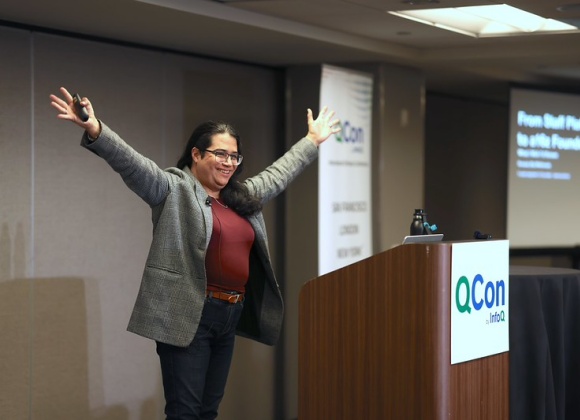In this podcast Shane Hastie, Lead Editor for Culture & Methods, spoke with Jarod Overson of Shape Security about the reason for and the content in the Beyond Being an Individual Contributor track at QCon San Francisco, and he offers advice for current and aspirant technical leaders.
Key Takeaways
- Many technologists get the opportunity to move into leadership roles but receive no training or guidance about what skills such a role needs
- Solving other people’s problems as quickly as possible is an important aspect of a leadership role – this is very different to being an individual contributor where the focus is on solving your own problems
- Advice for aspirant leaders: assume you are in the role you want and practice doing everything you think should be done in that role
- There is a bias among software developers against what is perceived as “old” knowledge – practices that have been around for decades and centuries – this is very wrong
- The problems of software engineering have not yet all been solved so there is still a lot of learning to be done, you can’t just repeat what has been done elsewhere before and expect it to work
- Software engineering is a creative, artistic skill done by creative, artistic people and a leader needs to understand how such people are motivated
- Culture and motivation comes from the top of a company and spreads all the way down
Subscribe on:
Sponsored by
Ocado Technology: This podcast is brought to you by Ocado Technology, a division of the Ocado Group. Ocado Technology builds the software and systems powering Ocado.com, the world's largest online-only grocery retailer. We’ve been disrupting the grocery industry for over fifteen years using the cloud, robotics, AI, and IoT. Find out more and check out career opportunities here.
- 0:40 Introductions
- 1:25 Many technologists get the opportunity to move into leadership roles but receive no training or guidance about what skills and knowledge a leadership role needs
- 2:12 Jarod’s own story of becoming a technical leader
- 3:25 Shape Security’s growth is giving Jarod insight into how leadership can grow as an organisation scales up
- 3:48 The overall design of the track was intended to give people a view of the range of leadership competencies needed when they want to step up
- 4:08 Matt Abraham’s talk on public speaking.
- 4:32 Public speaking really hard and it is an important leadership skill, so getting training is important
- 4:40 Ivana McConnell’s talk on mentorship as a path for empowering others
- 5:03 Tasneem Minadakis spoke about delivering effective feedback and developing coaching techniques
- 5:10 Coaching and mentoring are different competencies and require different approaches
- 5:36 Ariya Hidayat explained the key skills engineering leaders need to have which are distinct from the technical skills
- 6:04 Josh Evans opened the track exploring his own experiences as a leader at Netflix
- 7:02 Jarod’s own experience of moving into a leadership heavy role was very difficult
- 7:31 Solving other people’s problems as quickly as possible is an important aspect of a leadership role – this is very different to being an individual contributor where the focus is your own problems
- 7:56 The realisation that solving problems at the leadership level has a far bigger impact than solving problems at the individual or team level
- 8:27 Advice for aspirant leaders: assume you are in the role you want and practice doing everything you think should be done in that role
- 8:38 The most effective leaders are the ones who take up the leadership mantle before the formal opportunity arises
- 9:13 There are lots of books which provide advice and guidance around the leadership topics
- 9:38 There is a bias among software developers against what is perceived as “old” knowledge – practices that have been around for decades and centuries – this is very wrong
- 10:05 The leadership challenges of today are still about dealing with people
- 10:14 What is different is the pace at which things happen – the ability to make mistakes comes faster
- 11:26 The problems of software engineering have not yet all been solved so there is still a lot of learning to be done, you can’t just repeat what has been done elsewhere before and expect it to work
- 11:48 There is a disconnect in many technologists’ minds between their technical practices and the value their software provides to customers
- 12:57 Cloud platforms are an example of how the perceived “solutions” to the problems of deploying massive applications was completely invalidated
- 13:43 There needs to be continuous realignment towards an end goal – constant learning
- 14:14 The need to focus on getting to value as quickly as possible
- 14:55 Software engineering is a creative, artistic skill done by creative, artistic people and a leader needs to understand how such people are motivated
- 15:08 It is incredibly demotivating to have a leader try and squeeze out as much code as possible without taking into account the person behind the code
- 15:41 Examples of simple techniques which increase motivation include hack-days done with clear goals and communication; ensuring there is flexibility around personal time;
- 16:20 Showing support and care for all aspects of people’s lives is important to help people remain motivated
- 16:50 It is very important to have people who show empathy and care rise to leadership faster than people who just show technical expertise
- 17:28 In most organisations the people who show the best technical expertise are the most likely to be promoted into people management positions, often positions for which they are not at all suited
- 18:14 The way Shape is attempting to address the challenges of career paths for people that may not want or be suited to people management. They provide three pathways – people, technical and architectural skills
- 20:14 Examples of what it takes to make an environment that people want to work in
- 20:48 Pay attention to factors such as physical layout and lighting – and the danger of not doing so
- 21:44 Learning from what Apple has done with the design of their office environment
- 22:05 The way the core principles that drive the design of the Apple products are evidenced in the design of the environment
- 22:44 Culture and motivation comes from the top of a company and spreads all the way down
- 23:20 Saying “no” over and over when people want to work on new and interesting things will result in you losing the best people that you have
Mentioned:



